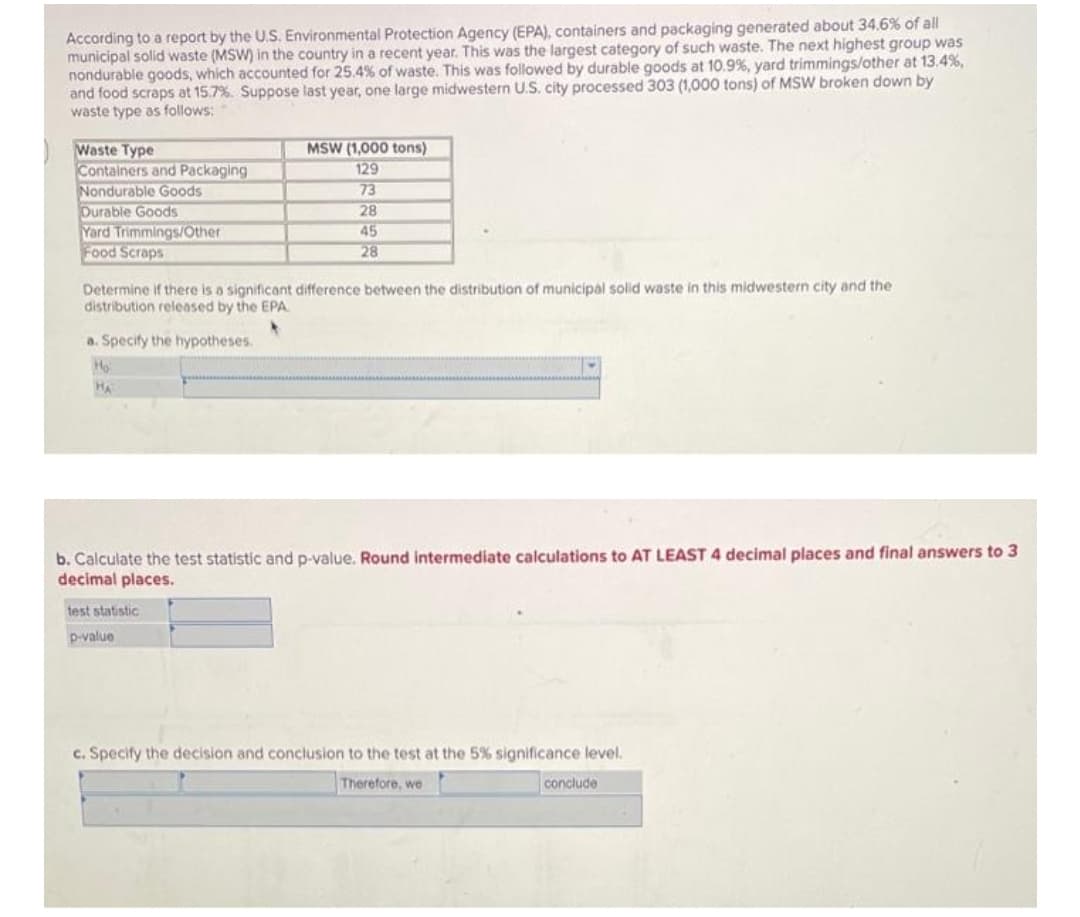According to a report by the U.S. Environmental Protection Agency (EPA), containers and packaging generated about 34.6% of all municipal solid waste (MSW) in the country in a recent year. This was the largest category of such waste. The next highest group was nondurable goods, which accounted for 25.4 % of waste. This was followed by durable goods at 10.9%, yard trimmings/other at 13.4%, and food scraps at 15.7%. Suppose last year, one large midwestern U.S. city processed 303 (1,000 tons) of MSW broken down by waste type as follows: Waste Type Containers and Packaging Nondurable Goods Durable Goods Yard Trimmings/Other Food Scraps MSW (1,000 tons) 129 73 28 45 28 Determine if there is a significant difference between the distribution of municipal solid waste in this midwestern city and the distribution released by the EPA a. Specity the hypotheses. HA b. Calculate the test statistic and p-value. Round intermediate calculations to AT LEAST 4 decimal places and final answers to : decimal places. test statistic p-value c. Specify the decision and conclusion to the test at the 5% significance level. Therefore, we conclude
According to a report by the U.S. Environmental Protection Agency (EPA), containers and packaging generated about 34.6% of all municipal solid waste (MSW) in the country in a recent year. This was the largest category of such waste. The next highest group was nondurable goods, which accounted for 25.4 % of waste. This was followed by durable goods at 10.9%, yard trimmings/other at 13.4%, and food scraps at 15.7%. Suppose last year, one large midwestern U.S. city processed 303 (1,000 tons) of MSW broken down by waste type as follows: Waste Type Containers and Packaging Nondurable Goods Durable Goods Yard Trimmings/Other Food Scraps MSW (1,000 tons) 129 73 28 45 28 Determine if there is a significant difference between the distribution of municipal solid waste in this midwestern city and the distribution released by the EPA a. Specity the hypotheses. HA b. Calculate the test statistic and p-value. Round intermediate calculations to AT LEAST 4 decimal places and final answers to : decimal places. test statistic p-value c. Specify the decision and conclusion to the test at the 5% significance level. Therefore, we conclude
Linear Algebra: A Modern Introduction
4th Edition
ISBN:9781285463247
Author:David Poole
Publisher:David Poole
Chapter7: Distance And Approximation
Section7.3: Least Squares Approximation
Problem 31EQ
Related questions
Question

Transcribed Image Text:According to a report by the U.S. Environmental Protection Agency (EPA), containers and packaging generated about 34.6% of all
municipal solid waste (MSW) in the country in a recent year. This was the largest category of such waste. The next highest group was
nondurable goods, which accounted for 25.4 % of waste. This was followed by durable goods at 10.9%, yard trimmings/other at 13.4%,
and food scraps at 15.7%. Suppose last year, one large midwestern U.S. city processed 303 (1,000 tons) of MSW broken down by
waste type as follows:
Waste Type
Containers and Packaging
Nondurable Goods
Durable Goods
Yard Trimmings/Other
Food Scraps
MSW (1,000 tons)
129
73
28
45
28
Determine if there is a significant difference between the distribution of municipal solid waste in this midwestern city and the
distribution released by the EPA
a. Specify the hypotheses.
Ho
HA
b. Calculate the test statistic and p-value. Round intermediate calculations to AT LEAST 4 decimal places and final answers to 3
decimal places.
test statistic
p-value
c. Specify the decision and conclusion to the test at the 5% significance level.
Therefore, we
conclude
Expert Solution
This question has been solved!
Explore an expertly crafted, step-by-step solution for a thorough understanding of key concepts.
This is a popular solution!
Trending now
This is a popular solution!
Step by step
Solved in 3 steps with 5 images

Recommended textbooks for you

Linear Algebra: A Modern Introduction
Algebra
ISBN:
9781285463247
Author:
David Poole
Publisher:
Cengage Learning

Glencoe Algebra 1, Student Edition, 9780079039897…
Algebra
ISBN:
9780079039897
Author:
Carter
Publisher:
McGraw Hill

Linear Algebra: A Modern Introduction
Algebra
ISBN:
9781285463247
Author:
David Poole
Publisher:
Cengage Learning

Glencoe Algebra 1, Student Edition, 9780079039897…
Algebra
ISBN:
9780079039897
Author:
Carter
Publisher:
McGraw Hill